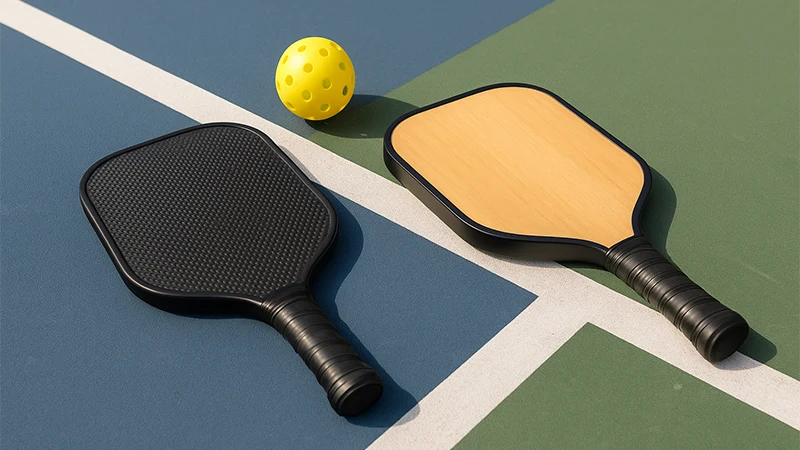Types of Pickleball Paddles: Core, Shape, Weight & Surface Guide

CEO & Technical Expert at Pickleball Equipment Company (Art Pickleball)
Specialize in manufacturing pickleball paddles, pickleball balls, and pickleball accessories.

Pickleball paddles come in many forms. They vary by core structure, face material, shape, and weight. Each type can change how a paddle feels, how much power it gives, and how it fits your playing style.
In this guide, we’ll explain the main types of pickleball paddles, including advanced core designs like MPP and ERA, so you can make the right choice.
The 4 Ways to Classify Types of Pickleball Paddles
Not all pickleball paddles are created the same. In fact, most paddles can be classified in four key ways. Understanding these categories will help you compare options more clearly and choose what works best for your game or customer base.
Here are the four main ways to classify pickleball paddle types:
- Face Material: What the paddle surface is made of—such as graphite, fiberglass, carbon fiber, or wood—affects feel, spin, and power.
- Core Structure: The inner core influences paddle response, control, and noise level. Options include honeycomb polymer, foam, or advanced layered designs like MPP or ERA.
- Shape and Size: Paddle shape determines your reach, sweet spot, and swing style. Common options include standard, widebody, elongated, and edgeless paddles.
- Weight Class: Light, mid-weight, or heavy paddles all offer different levels of speed, power, and arm fatigue.
Each of these will be covered in detail in the below.
Pickleball Paddle Types by Surface Material
The pickleball paddle face is the part that contacts the ball. Its material plays a big role in how the paddle feels, how much power or control it delivers, and how much spin you can generate. Below are the most common face materials you’ll see on the market.
Wood
Wood pickleball paddles were the original standard in pickleball. They’re solid, durable, and usually the lowest-cost option. But they’re also the heaviest and offer very little touch or spin. Most entry-level wooden paddles are made for casual or recreational use.
Best for: Beginners on a tight budget or large group play (like schools or camps)
Graphite
Graphite pickleball paddles are known for their light weight and responsive touch. The graphite face is thin and stiff, which helps transfer energy quickly and gives players great control. These paddles are popular among players who prioritize precision over power.
Best for: Control players, net players, and those wanting a faster reaction off the paddle
Fiberglass
Fiberglass pickleball paddles offer a softer face compared to graphite, which allows for better ball compression and spin. They’re usually paired with a polymer core, making them a strong choice for players who like a mix of power and finesse.
Best for: All-around players and anyone looking for more pop and spin
Carbon Fiber
Carbon fiber pickleball paddles are typically found in high-end performance models. The material is stiff and textured, allowing for excellent spin and a controlled, “soft” touch on the ball. These paddles are also highly durable.
Best for: Competitive players who value spin, feel, and consistency
Composite & Hybrid Materials
Many modern paddles use a combination of materials to balance power, control, and durability. For example, a paddle may have a fiberglass face reinforced with carbon fiber layers, or use textured coatings for added spin.
Best for: Players who want balanced performance or prefer new-generation paddle designs
Pickleball Paddle Types by Core Material & Internal Structure

The core of a pickleball paddle affects how it feels, how much power or control it gives, and how it handles vibration. It also plays a role in sound and long-term durability.
Modern paddles use a range of core types—from basic honeycomb to advanced multi-layer foam. Here’s a breakdown of the most common and latest designs.
PP Honeycomb Core
Polypropylene (PP) honeycomb is the most widely used paddle core. It’s lightweight, soft, and offers quiet play with balanced control. The honeycomb structure also keeps the paddle responsive without feeling too stiff.
Best for: All-around players and clubs looking for quiet, durable paddles
Aramid Core / Gen 4
Aramid cores (similar to Nomex) are made of fiber-based honeycomb material. They’re harder and louder than PP, with faster rebound and a crisper feel. Gen 4 versions use refined aramid layers to reduce harsh vibration while keeping the pop.
Best for: Competitive players who want fast response and a firm feel
EPP Core
Expanded Polypropylene (EPP) is a foam-like material with excellent vibration dampening. It creates a soft, muted feel and reduces arm fatigue. It’s often used in thicker paddle designs focused on control.
Best for: Control players or those with joint sensitivity
PP+ETP / EPP+ETP (Enhanced Support Structure)
These paddles use a main PP or EPP core supported by ETP (engineered thermoplastic) internal frames or inserts. This gives extra strength and impact resistance, especially near the edges or center.
Best for: Players who want durability without losing feel
EPP-WAVE (Wave Energy Control)
EPP-WAVE paddles use wave-shaped foam channels to improve energy transfer and reduce dead spots. The structure allows the paddle to flex more naturally on contact, offering better feel and directional control.
Best for: Intermediate to advanced players who want extra touch
ERA Core (PP + EVA Foam Edge Reinforcement)
The ERA design combines a traditional PP honeycomb core with EVA foam along the edge. This edge reinforcement absorbs impact, expands the sweet spot, and improves consistency on off-center hits.
Best for: Players who want more forgiveness, especially in doubles
MPP Core (High-Density Foam + EVA Shell)
MPP stands for Micro-Precision Polymer, a next-generation high-density foam core. It’s layered with an EVA outer edge for vibration reduction and stability. The result is a paddle that feels consistent across the entire surface with less shock on your hand.
Best for: Competitive players, pro-level users, or custom paddle buyers
BOOM & Next-Gen Tech (Custom/Internal Naming)
Some brands develop their own proprietary cores, such as BOOM™, which may combine thermoforming, foam-injected edges, or layered composite tech. These designs often aim to maximize control, power, or spin beyond traditional cores.
Best for: Innovation-driven players and product developers
Pickleball Paddle Types by Shape and Dimensions
The shape and size of a pickleball paddle can impact your reach, your control at the net, and how much room you have to work with in the sweet spot. While materials and cores affect feel and power, the shape defines how the paddle plays in real-game movement.
Let’s look at the most common paddle shapes and dimensions.
Standard
The standard shape is the classic all-purpose paddle. It usually measures about 15.5 inches long and 7.75 inches wide. It offers a balanced sweet spot and even weight distribution, making it easy to control.
Best for: Beginners and all-around players who want a familiar, reliable shape
Widebody
Widebody paddles have an extra inch or more in width. The wider surface area increases the sweet spot and makes off-center hits more forgiving. While you lose a bit of reach, you gain confidence in fast exchanges.
Best for: Recreational players or anyone who wants more hitting surface
Elongated
Elongated paddles are longer and slightly narrower—usually around 16.5 inches long and 7.25 inches wide. This added length gives more reach and power, especially helpful for singles play or overhead shots. The sweet spot is smaller but higher up on the face.
Best for: Singles players or those who prefer more reach and leverage
Teardrop & Hybrid
These paddles fall between widebody and elongated styles. The teardrop shape rounds the top edge, shifting the balance point slightly forward. Hybrids blend width, length, and taper to offer a balanced feel with a modern design.
Best for: Players who want something in between—control with just enough reach
Edgeless
Edgeless pickleball paddles remove the traditional edge guard, giving you more usable face area and a clean, modern look. They feel faster in the hand but may be more prone to damage on impact without protective tape or framing.
Best for: Players who want a full-face feel or a sleek design without distraction
Thickness (13mm vs 16mm)
Paddle thickness isn’t always obvious, but it changes how the paddle plays. Thicker paddles (around 16mm) offer more control and reduce vibration. Thinner paddles (13–14mm) tend to deliver more power and “pop” on contact.
Best for:
- 16mm: Control-focused players or those with sensitive joints
- 13mm–14mm: Power hitters or players who prefer a fast rebound
Paddle Weight Types: Light, Mid, and Heavy
Pickleball paddle weight plays a major role in how a paddle swings, how much power you generate, and how much control you feel. It also affects wrist speed, arm fatigue, and shot consistency—especially over long matches.
Most paddles fall into one of three weight categories. Let’s break down the pros and cons of each type.
Lightweight Pickleball Paddles
Approx. 6.8–7.4 oz
Lightweight pickleball paddles are easy to maneuver and help with quick reactions at the net. They reduce strain on the arm and are a common choice for players with joint concerns or fast hand speed.
Pros:
- Faster swing speed
- Easier on the elbow and shoulder
- Great for dinking and soft touch shots
Cons:
- Less natural power on drives and serves
- May feel unstable against hard shots
Best for: Control players, doubles specialists, kids, or anyone prone to tennis elbow
Midweight Pickleball Paddles
Approx. 7.5–8.4 oz
Midweight pickleball paddles offer a balanced feel between speed and power. This is the most popular weight range, suitable for almost every playing style and level.
Pros:
- Good mix of power and control
- Versatile for all play styles
- Feels comfortable for most users
Cons:
- May feel average—not tailored to a specific strength
Best for: All-around players and most beginners looking for one paddle that does everything well
Heavyweight Pickleball Paddles
Approx. 8.5 oz and up
Heavier pickleball paddles generate more power with less effort in the swing. They’re effective for baseline shots and serve returns but can be tiring over time.
Pros:
- More power with less effort
- Solid feel on hard drives
- Stability on off-center hits
Cons:
- Can cause fatigue in long matches
- Slower at the net and in fast volleys
- Higher strain on wrist and shoulder
Best for: Power hitters, singles players, or strong players who don’t mind the extra weight
Side-by-Side Comparison Table
| Weight Class | Speed | Power | Control | Fatigue Risk | Best Use Case |
|---|---|---|---|---|---|
| Lightweight | ★★★★★ | ★★☆☆☆ | ★★★★☆ | Very Low | Net play, control, low impact |
| Midweight | ★★★★☆ | ★★★★☆ | ★★★★☆ | Low | Balanced play, all-around use |
| Heavyweight | ★★☆☆☆ | ★★★★★ | ★★☆☆☆ | High | Power shots, singles, baseliners |
Choosing the Right Pickleball Paddle for Your Game
With so many paddle options out there, it’s easy to feel overwhelmed. The key is to break your decision down into a few simple steps. Whether you’re choosing for yourself, your club, or your business, the right paddle should fit your playing style and long-term needs.
Here’s a quick step-by-step guide to help you choose with confidence.
Step 1: Define Your Play Style
Start with how you play—or how you want to play.
- Do you like soft shots and control at the net?
- Do you rely on power and drives from the back court?
- Are you focused on spin and fast hands during rallies?
Your play style will guide almost every other paddle decision, from shape to surface to weight.
Step 2: Match Shape, Core, and Face Material
Once you know your style, pick paddle features that match it:
- Control players often prefer 16mm paddles with a soft face (like carbon fiber) and a PP or EPP core.
- Power players lean toward thinner paddles (13–14mm), firmer cores (like Aramid), and textured fiberglass or hybrid surfaces.
- Spin-heavy players benefit from raw carbon or sanded surfaces with a responsive foam or polymer core.
- All-around players should look for a midweight paddle with balanced specs across all features.
Not sure how to match features to your goals? See our full guide on how to choose a pickleball paddle for deeper advice.
Step 3: Think Long-Term
Paddle choice isn’t just about feel—it’s also about longevity, injury prevention, and room to grow.
- If you play often, look for durable materials and edge protection.
- If you have elbow or wrist issues, avoid heavy paddles with hard cores.
- If you plan to improve, consider mid-range paddles with upgrade paths in weight or shape.
Choosing the right paddle now can help prevent discomfort and keep your game improving over time.
Step 4: What Clubs, Teams, and Resellers Should Consider
If you’re buying paddles for a club, brand, or resale, think beyond the individual player:
- Look for durability and consistency across batches
- Choose materials that suit your audience (e.g., control paddles for school programs, spin paddles for competitive teams)
- Ask about customization options: colors, logos, surface textures
- Work with a manufacturer who understands your needs and offers technical support
Need help choosing paddles in bulk or designing your own line? Our team can help you build or source the right paddles for your players and customers.
Which Paddle Type Is Best for You?
Now that you know how paddles differ by material, core, shape, and weight, the next step is choosing what fits your needs in the real world. Here are four common player and buyer scenarios—with direct paddle type recommendations for each.
Scenario: You’re a Spin-Heavy Player
You rely on topspin, slices, and controlled placement. You want a paddle that grabs the ball and holds it just long enough to shape your shots.
Best Paddle Type:
- Face: Raw carbon fiber or textured fiberglass
- Core: PP honeycomb or MPP foam for a soft, controlled feel
- Shape: Elongated or hybrid for added reach and spin angles
- Thickness: 14–16mm for more dwell time
Why: A textured face helps you generate spin, while a softer core gives you better feel and control on touch shots.
Scenario: You Coach a School Team
You need paddles that are durable, affordable, and easy to use across different skill levels. Consistency and comfort matter more than specialized features.
Best Paddle Type:
- Face: Fiberglass or composite
- Core: PP honeycomb for quiet, balanced play
- Shape: Standard or widebody for bigger sweet spots
- Weight: Midweight (7.5–8.3 oz)
Why: These paddles are forgiving, low-maintenance, and versatile—perfect for group training and varied player skill levels.
Scenario: You’re Starting a New Paddle Brand
You’re sourcing or designing paddles and want a lineup that appeals to real player needs. You need performance options and room for customization.
Best Paddle Type:
- Face: Mix of carbon fiber (for premium) and fiberglass (for mid-range)
- Core: Offer PP, MPP, and foam-edged options (ERA or EVA wrap)
- Shape: Provide standard, elongated, and hybrid options
- Extras: Consider edgeless design or thermoformed construction
Why: Offering variety helps you position your brand for different player types. Choosing the right core + face combos gives you a real performance edge.
Scenario: You Need a Silent Paddle for Indoor Clubs
Noise complaints or sensitive indoor settings make paddle acoustics a factor. You want soft sound without sacrificing too much playability.
Best Paddle Type:
- Face: Graphite or carbon fiber (quiet, low-vibration)
- Core: EPP, MPP, or PP with EVA edge damping
- Shape: Standard or widebody for control
- Thickness: 16mm for extra quiet contact
Why: These setups absorb more vibration and reduce “pop” sounds, making them ideal for indoor use or noise-sensitive environments.
Conclusion
Pickleball paddles come in many types, each with its own feel, weight, and performance. Knowing the differences helps you choose the right one for your game or your players.
Need help finding the right paddle or building your own lineup? Get in touch—we’re here to help.
Frequently Asked Questions
Q1. What paddle core is best for control?
Polypropylene (PP) and MPP foam cores are top choices for control. They absorb more vibration and offer a softer feel, giving players better touch at the net. Thicker cores, like 16mm, also help with precision by reducing paddle bounce and creating a larger, more stable sweet spot.
Q2. What is MPP foam in pickleball paddles?
MPP stands for Micro-Precision Polymer, a high-density foam core designed for consistent rebound and vibration dampening. Often paired with EVA foam around the edges, it offers a solid, low-shock playing feel. MPP is one of the newest technologies in high-performance pickleball paddles, used in advanced or pro-level designs.
Q3. Are edgeless paddles better?
Edgeless paddles remove the traditional edge guard, giving players more surface area and fewer mishits off the rim. They feel faster in hand and have a sleek look. However, they may be more prone to chipping without protective tape. They’re not better for everyone, but ideal for players who want a cleaner, full-face hitting zone.
Q4. What’s the quietest paddle material?
Graphite and carbon fiber faces paired with a polypropylene or EPP core are among the quietest combinations. These materials absorb more impact and reduce “pop” sounds, making them ideal for indoor use or noise-sensitive environments. Thicker paddles (16mm) also help lower sound and vibration levels during play.
Q5. Do paddle cores affect spin?
Yes. While surface texture plays the biggest role in spin, the core matters too. Softer cores like PP or MPP allow the ball to dwell slightly longer on the face, giving players more control over spin. A firmer core may release the ball faster, reducing the chance to shape the shot.
